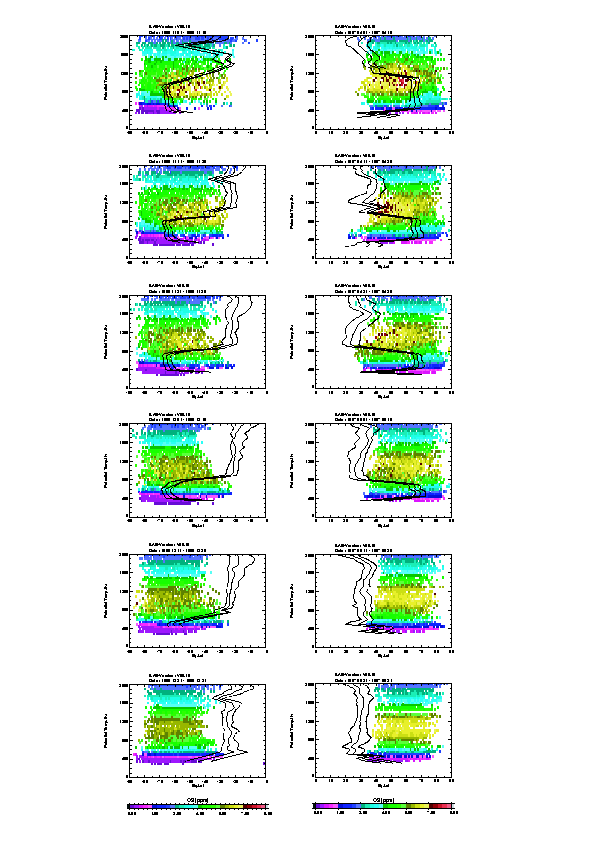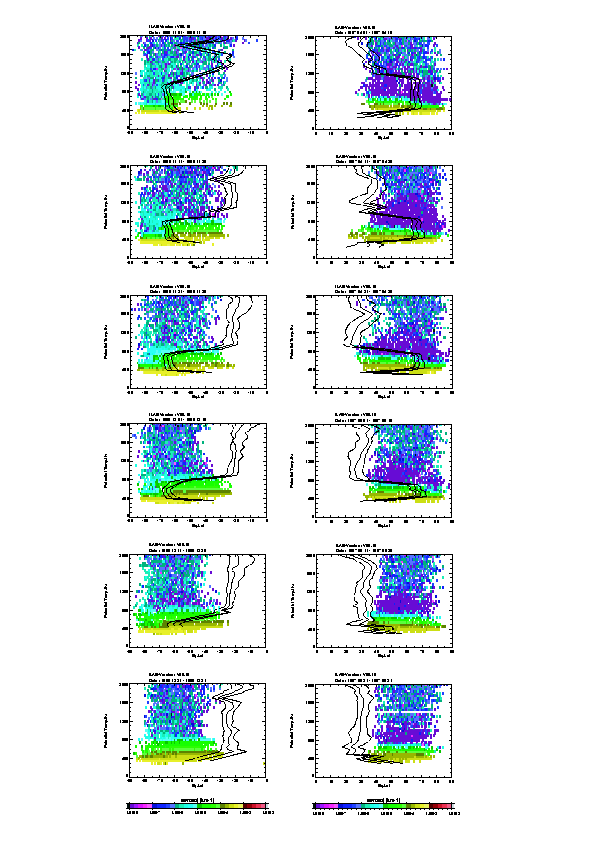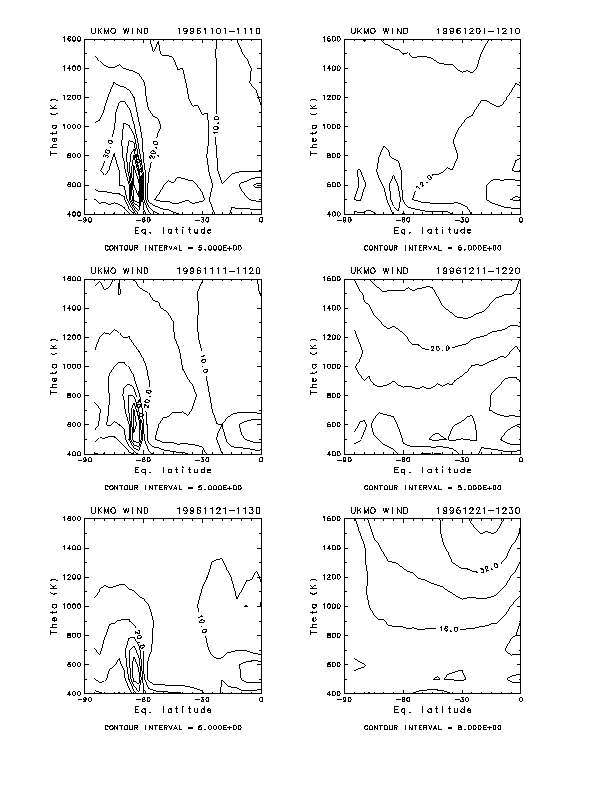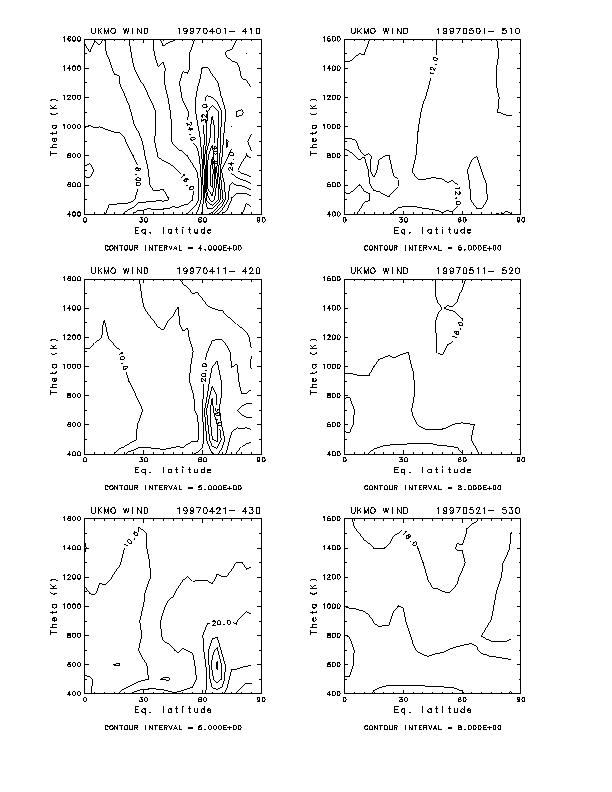
Previous: Characteristics of ILAS Measurements Next: Summary Up: Ext. Abst.
3. Results
3.1. Dynamic Tracers
Mixing ratios of dynamic tracers (CH4 and N2O) measured by ILAS were plotted in Figures 3 and 4 in the equivalent latitude-potential temperature plane (hereafter, we call EL-PT plot) in each 10-days periods at the time of polar vortex breakup, i.e., 1996/11/1-10, 11/11-20, ..., 12/21-31 for the SH, and 1997/4/1-10, 4/11-20, ..., 5/21-31 for the NH. Polar vortex boundaries (inner, center, outer) defined with the method by Nash et al. [1996] are also plotted on these figures. It is shown that polar vortex started to break from upper altitudes. As the vortex breaks up, it can be seen that the air outside the vortex which contains higher mixing ratios of tracer species mixed with the air inside the vortex with smaller mixing ratios. This mixing started to occur at higher altitudes (900K for CH4, and 800K for N2O), followed by lower altitudes.

Fig. 3. Time variation of mixing ratio of CH4 in Equivalent Latitude-Potential Temperature plane.

Fig. 4. Time variation of mixing ratio of N2O in Equivalent Latitude-Potential Temperature plane.
3.2. Photochemical Species
Mixing ratios of photochemical species (O3 and NO2) measured by ILAS were plotted in Figures 5 and 6 in the EL-PT plane in the same 10-days periods at the time of polar vortex breakup. It is shown that mixing of airmass occurred at much higher altitudes (1100K for O3, and 1000K for NO2) in earlier periods (11/11-20 for the SH, and 4/11-20 for the NH) compared with dynamic tracer cases (12/1-10 for the SH, and 5/1-10 for the NH). This is because polar vortex boundaries have disappeared earlier at higher altitudes. These differences in mixing altitude and time between photochemical species and dynamic tracers are caused mainly by the differences in vertical distribution of maximum mixing ratio. However, this could give us very good indication on how mixing of air between outside and inside the polar vortex occurs at the time of the breakup of polar vortex.

Fig. 5. Time variation of mixing ratio of O3 in Equivalent Latitude-Potential Temperature plane.

Fig. 6. Time variation of mixing ratio of NO2 in Equivalent Latitude-Potential Temperature plane.
3.3. Lower Stratospheric Species
Mixing ratios of HNO3, and aerosol extinction coefficients at 780 nm measured by ILAS were plotted in Figures 7 and 8 in the EL-PT plane in the same 10-days periods at the time of polar vortex breakup. It is shown that mixing of airmass occurred at lower altitudes (500-600K for both HNO3 and aerosols) in later periods (12/11-20 for the SH, and 5/11-20 for the NH) compared with dynamic tracer cases (12/1-10 for the SH, and 5/1-10 for the NH). This is because polar vortex boundaries breakup is later at lower altitudes. Again, these differences in mixing altitude and time give us very good indication on how mixing of air between outside and inside the polar vortex occurs at the time of the breakup of polar vortex. Also note that below 500K, polar vortex boundary is not stable even during winter, which enables mixing of air along the meridian.

Fig. 7. Time variation of mixing ratio of HNO3 in Equivalent Latitude-Potential Temperature plane.

Fig. 8. Time variation of aerosol extinction coefficients at 780 nm in Equivalent Latitude-Potential Temperature plane.
3.4. Wind Field
In order to see how the vortex boundary is formed and how it started to disappear, horizontal wind velocities (SQRT(u*u+v*v)) are plotted in Figures 9 and 10 in EL-PT plane in the same 10-day periods at the time of polar vortex breakup. It is shown that strong winds of more than 40 m/s at +/- 60 degrees existed during the winter, which play an important role in separating air mass between inside and outside the polar vortex. It is clearly shown that this strong wind started to weaken and disappear from upper altitudes at the time of breakup of polar vortex, enabling the meridional mixing of air.

Fig. 9. Time variation of horizontal wind velocity field in Equivalent Latitude-Potential Temperature plane in the Southern Hemisphere for 10-day periods from November 1-10 to December 21-31, 1996.

Fig. 10. Time variation of horizontal wind velocity field in Equivalent Latitude-Potential Temperature plane in the Northern Hemisphere for 10-day periods from April 1-10 to May 21-31, 1997.